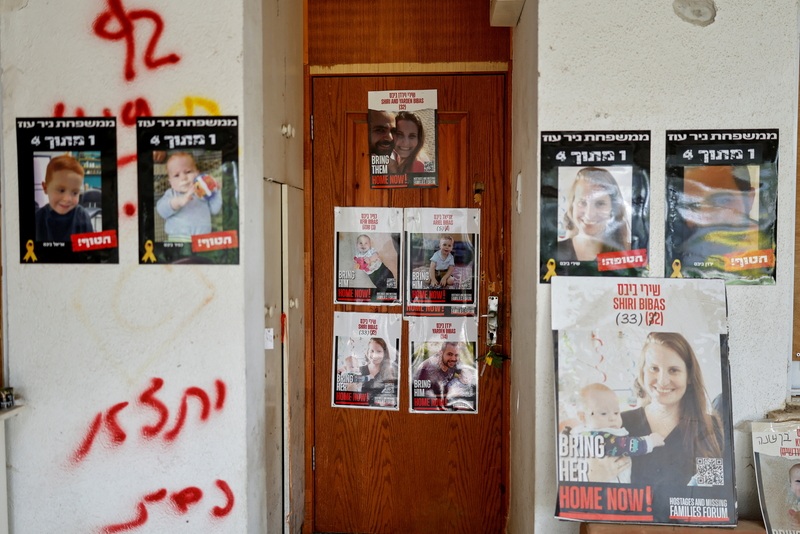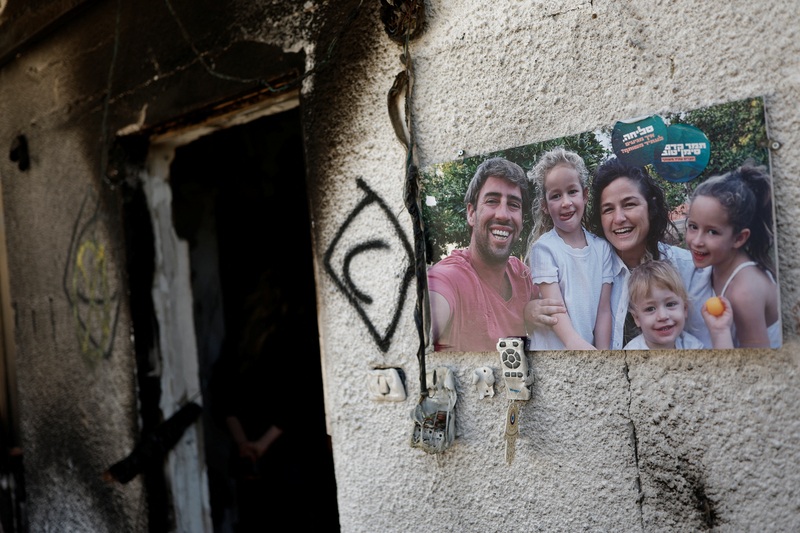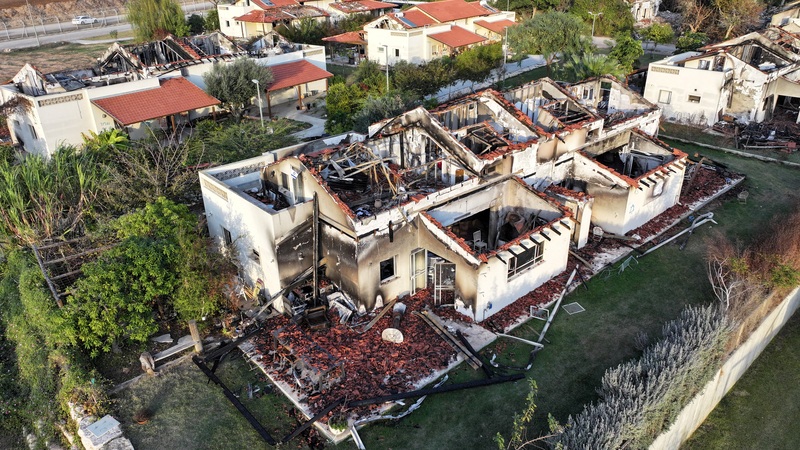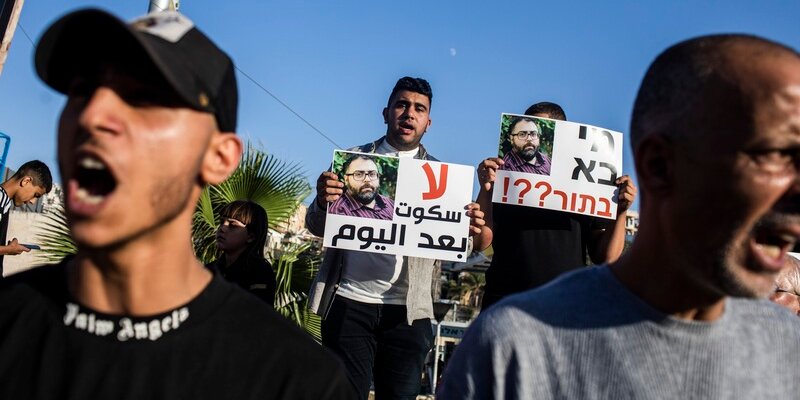How Netanyahu’s Government Is Rewriting the Memory of October 7
The prime minister has not taken responsibility for the failings that led to the massacre, but the minister responsible for passing a law commemorating the October 7 disaster is none other than Benjamin Netanyahu. He will be in charge of the national memorial site, he will control the official archive that decides which testimony to keep and which to discard, and he will appoint members of the council that will receive all the commemoration funding. A Shomrim investigation highlights the battle for the memory of October 7. Published also in N12


The prime minister has not taken responsibility for the failings that led to the massacre, but the minister responsible for passing a law commemorating the October 7 disaster is none other than Benjamin Netanyahu. He will be in charge of the national memorial site, he will control the official archive that decides which testimony to keep and which to discard, and he will appoint members of the council that will receive all the commemoration funding. A Shomrim investigation highlights the battle for the memory of October 7. Published also in N12

The prime minister has not taken responsibility for the failings that led to the massacre, but the minister responsible for passing a law commemorating the October 7 disaster is none other than Benjamin Netanyahu. He will be in charge of the national memorial site, he will control the official archive that decides which testimony to keep and which to discard, and he will appoint members of the council that will receive all the commemoration funding. A Shomrim investigation highlights the battle for the memory of October 7. Published also in N12
Netanyahu on the Knesset podium and the memorial site in Nova, which was established by bereaved parents. Photos: Reuters. Image processing: Noam Tamari

Shuki Sadeh
November 20, 2025
Summary


Listen to a Dynamic Summary of the Article
Created using NotebookLM AI tool
Command and Staff College in Glilot to the Begin Heritage Center in Jerusalem. They also proposed raising the remains of the vessels from the seabed. Katz agreed to the request, saying that he would order the IDF to relocate the cannon – much to the satisfaction of “the base.”
October 7, however, remains a unique case. “It is obvious that a lot of people have an interest in shaping our memory of it,” says Prof. Renana Keydar, a professor of law and digital humanities at the Hebrew University, whose research focuses on memory and legacy. “One of the things that makes October 7 so unique is that it did not take even a single day before efforts began to shape the collective memory of the event. Immediately, the public had video footage of terrorists, from the young people at the Nova festival, from WhatsApp and from safe-rooms; this was an event that was documented in real time. Two years later, we have quantities of information that once would have taken 40 years to accumulate. So, we can also argue about what should be included, what should be preserved and what we prefer to ignore and erase.”
Keydar is part of Edut 710, a collective of documentarians and volunteers who, working with the Hebrew University, have collected around 1,700 pieces of video evidence from survivors, freed hostages and their families. In the first days of the war, the collective interviewed some 200 members of the Kibbutz Be’eri; for the time being, at the request of the subjects, these interviews are yet to be published. “Edut 710 is an apolitical body; it’s not a media body for hasbara and it’s not propaganda. And when the days comes that someone wants to know what happened on October 7, they will have the most layered picture possible. We are committed to listening to everyone – not just the loudest and most prominent voices.”
In addition to Edut 710, there are several other private initiatives worth mentioning, including those that collect visual evidence and those involved in physical documentation and building memorials. Among them are initiatives by Steven Spielberg’s USC Shoah Foundation and Kan, Israel’s public broadcasting body. Israel’s National Library also has more than 250,000 videos on its website – for which the Ministry of Heritage provided funding to the tune of 27 million shekels for the next three years.
The activism of various civilian organizations shines a harsh light on the fact that, two years after October 7, the government has still not passed a law commemorating the war. There is no guiding hand from within the government – a body with regular funding, capable of managing the issues of commemoration and legacy in an ordered and uniform manner. A February 2025 state comptroller’s report was critical of this very issue, warning, among other things, that the current situation has allowed the establishment of many private memorial sites at communities in the Western Negev, something that interferes with the daily life of residents – especially those who returned to their homes in the aftermath of the massive trauma they experienced.
The Hillula held on Simhat Torah at the Re’im parking area is just one example of this. At the site of the Nova festival itself, which sees tens of thousands of visitors every month, is a memorial built thanks to an initiative by a group of bereaved parents, the most vocal of whom are Yoram Yehudai and Meir Zohar. They were assisted in the project by artist Amir Chodorov, who not only volunteered his time turning the site into a memorial, but also his own money. The site displays images of the victims, alongside accounts of what happened at each part of the parking area on that horrific day. For example, there’s the container where some of the victims tried to hide. The project was approved by Keren Kayemeth LeIsrael-Jewish National Fund, which also participated in it – but without any state involvement. According to Zohar, it is only now that authorities are discussing how to fence off the area to prevent incidents like the unauthorized Simhat Torah Hillula.
Incidentally, one site in which the state has involved itself is the collection of burnt-out cars near Moshav Tkuma. Inside sources say that, since the site operates under the auspices of the Ministry of Heritage, it is closed to the public on Shabbat and Jewish holidays.


Memorializing the massacre or ‘the events of Tishrei 22’
Even the legislation currently making its way through the Knesset is the result of a civilian initiative. It was started by Dekel Lifschitz, grandson of released hostage Yocheved Lifschitz and Oded, who was murdered in captivity in Gaza. Around a year ago, he sought to rally lawmakers’ support for a bill that would enshrine the commemoration of October 7 in law; at the time, one of his goals was to keep the campaign for the return of the living hostages in the headlines. In the end, several private bills have been submitted to the Knesset, bearing the signatures of 86 lawmakers from all factions.
These private bills have been unified into a single piece of legislation. Discussions were held in the Knesset’s Education Committee, under the chairmanship of MK Yosef Taieb (Shas), until the government finally entered the picture with a bill of its own. Along with Yoel Elbaz – the Noam campaign manager and PMO official mentioned above – attorney David Yamin, the PMO’s legal adviser, also attended the sessions. Early in 2025, the Prime Minister’s Office began to put together a proposal for a government-sponsored bill that would be discussed in parallel with the discussions in the Education Committee. In June, the draft of the government bill was published and it was submitted by Netanyahu himself. At the same time, representatives of the PMO and other ministries participated in Education Ministry discussions about the private bills. In July, the unified private bill was approved by the committee, ahead of its first reading in the Knesset and the plan was that it would subsequently be merged with the government bill. However, due to the ultra-Orthodox parties quitting the coalition, the bill was never brought to the vote.
While the committee barely discussed the fact that Netanyahu would be the minister responsible for the law, minutes of the meeting nonetheless reveal something about the power struggles and disagreements that exist over shaping the narrative. From the very outset of discussions, an argument rumbled on over the date to be mentioned in the name of the law – October 7 or Tishrei 22 – the Gregorian or Hebrew calendar. In addition, representatives of bereaved families wanted some mention of the neglect, the massacre and so on.
The private bill that is still moving through parliament does mention the word “massacre” and, at least for the time being, the bill called The Massacre Remembrance and Commemoration of Heroism Bill. The government-sponsored bill that is taking shape, in contrast, does not include the word “massacre” and refers to “the events of Tishrei 22/October 7.” This is in keeping with the bill submitted immediately after the outbreak of the war by MK Etty Hava Atia (Likud), which also fails to use the word “massacre.” Around a year later, during a discussion in late October 2024 at the Knesset’s Education Committee, she accepted the fact that “massacre” would be included in her bill, but insisted that “Tkuma refers to the Gaza Envelope, to Lebanon, to Iran and to all the fronts that were opened against Israel.”
“I can unequivocally say that there were attempts to hijack the narrative during those discussions,” says Ayelet Sela-Yongerman, who represented the Kibbutz Movement at Knesset hearings. “The very fact that the prime minister will appointment members of the council [of the memorial authority that is to be established] is a perfect example. During discussions, there were huge arguments over semantics, which is, in fact, the narrative. For example, representatives of the Ministry of Education turned up and talked about the pedagogical program that should be introduced, about tours that schools will conduct to the main memorial site. It was all about heroism, heroism, heroism. October 7 was not just about heroism; it was a disaster.”
The committee also discussed the issue of the date that the commemoration would be held. Until now, during the two years that have passed, two dates have been marked: there was an event on the Gregorian date, organized by the Kumu (Awaken) movement established by bereaved brother Yonatan Shamriz, which was broadcast live on every Israeli television channel; and on Tishrei 22, the date that the government set aside for the commemoration (which is two days after Simhat Torah because of “Isru Chag”).
There was also a stormy argument during discussions among bereaved parents, some of whom insisted that the law determine October 7 as the official commemoration date, while others were equally adamant that the Hebrew date be observed. In the end, both the private bill and the government-sponsored legislation use Tishrei 22 – the Hebrew date – in accordance with the government’s wishes.


An independent archive or under the wings of the PMO?
Another major issue raised during the Education Committee’s discussions in the Knesset was whether the new authority would establish its own archive or operate under the auspices of the State Archive. Yad Vashem, for example, maintains one of the most significant Holocaust archives in the world.
At the hearing, however, the Prime Minister’s Office representative, attorney David Yamin, suggested that the State Archive should oversee the new authority’s archival work rather than allowing it to create an independent archive.
The government bill states that the new body may establish its own archive, but does not guarantee this. In contrast, the private bill explicitly requires the creation of an independent archive.
While this may look like mere semantics, it really isn’t. The State Archive is part of the PMO and operates under its auspices with all that entails. As such, it only collates government material and, even if it wanted to, it does not have the staffing or the funding to take on archiving the full wealth of documented material from October 7. Moreover, it is a “controlled” archive and, as such, does not release sensitive material for years, sometimes even decades.
Doron Aspir works in high-tech and is an expert on information systems. He is a civilian who, from almost the first day of the war, has been working to memorialize the victims. He attended every meeting of the Education Committee, spent many hours working on the issue and met with all of the relevant people. A policy paper that he submitted to the committee proposed that the new commemoration authority would have its own archive, based on several sources of information and various studies, and would make use of modern techniques and technologies. He told members of the committee that big-data processing is now much easier than in the past. “I have conversations with David Yamin,” Aspir says. “He did everything he could to make sure it was the State Archive. From what I understand, his insistence was due to the fact that the State Archive does not collect material that does not come from the state. After all, the State Archive would collect less than a data profile. There are massive projects – of which Edut 710 is just one. The National Library collects a lot of material, but, in the end, the authority that is set up will be the main commemoration body – and it would be utterly absurd if it did not have a large public archive. After all, what could be more logical than visiting the main memorial site and also having access to an archive that contains all of the documented evidence?”
Another thorny issue is where the main site will be located. During the legislative process, there were behind-the-scenes discussions which suggested that some government officials were pushing for the site to be in Jerusalem. In the end, however, both the private and the government-sponsored bills say that it will be built somewhere in the Western Negev. Where exactly, however, remains to be decided. Michal Uziyahu Peleg, head of the Eshkol Regional Council, told the Education Committee that she supports building the site at the Re-im parking area, arguing that this also makes sense because of the various memorials that have already been set up there. She added that neither Kibbutz Be’eri nor Kibbutz Nir Oz – for obvious reasons – want the main memorial site on their land. However, according to one source involved in the process, the government is inclined to push for the site to be built in Sderot, rather than in one of the Gaza Envelope communities.
“Here, too, I assume that the reason is political,” the source adds. “The location of the memorial center not only has significance in terms of financial income, but also in terms of controlling who is invited to give lectures and similar issues. It may only be a small advantage, but if the center is in a Likud-supporting town, it gives them another layer of control over the narrative.”

.jpg)
‘Blurring the truth and writing new narratives’
Both bills – the private and the government-sponsored – stipulate that the prime minister is responsible for the law. This is a decision that is important in two main areas: firstly, it allows the prime minister to appoint the members of the new authority’s board. These people will be responsible – certainly in the early stages – for hugely important decisions that will impact how the body operates, especially in terms of the location of a national memorial site. Secondly, the prime minister will be responsible for approving the body’s budget, which will come from the state coffers. It is still not clear what budget the authority will be given, but it will be entitled to distribute subsidies. This means that state funding will flow to external bodies; which bodies and which projects will be supported depends entirely on the identity of the council members that the prime minister selects.
The question of the identity of the members was raised in several of the Knesset Education Committee’s meetings. Among the questions asked were: How many members would there be on the body’s council and what would be the proportion of government representatives to members of the public? Similarly, would specific votes by the council require majority approval by the public representatives? The private bill stipulates that there will be 13 council members and that a majority – seven – would be public representatives; the government’s bill, in contrast, calls for 10 members, half representing the public and half from the civil service.
Both of the proposed laws stipulate that government representatives will be appointed by the directors-general of ministries, rather than the ministers, which should go some way to keeping political considerations out of the equation. One of the reasons for this stipulation is activity by civil society organizations that were involved in drafting the bill - one of which is the Manor Center for Policy thinktank. Having said that, the bill is still in its infancy and nothing is yet final.
If the question of public representation was significant in the committee hearings, there is a good chance that it will become critical during the next stages of the process. As things currently stand, there will be one representative each for the four regional councils in the area and one representative each from Sderot and Ofakim, the two towns attacked on October 7. The Tkuma Directorate wants to increase representation for residents of the Western Negev. Another difference between the government-sponsored and the private bill is that only the latter includes representation for the Kibbutz Movement, the Moshavim Movement or the Religious Kibbutz Movement, which would have a single representative between them.
An analysis of the discussions shows that the people most likely to fall between the cracks are the families of Nova massacre victims, many of whom already feel that they have been abandoned by the state. “The kibbutzim have their own framework. The IDF has the Rehabilitation Unit. But Nova families are not formally defined as a group from the establishment’s perspective,” says Yoram Yehudai, whose son Ron was murdered at the festival. “Bereaved parents of Nova victims were involved in a lot of independent activity, from setting up a memorial at the site and holding ceremonies to working with the National Insurance Institute to make sure families got their rights. The government still has not appointed a point person to specifically interface with Nova victims’ families.”
Yehudai is also a member of the October Council, the main goal of which is to force the government to establish a state commission of inquiry. Indeed, Yehudai and others raised that very issue at meetings of the Knesset’s Education Committee. He agrees that “those committee discussions were pretty vanilla.’ I got the impression that the government wants to blur the truth and write new narratives. You could see that quite clearly when they changed the name of the war. After all, in the end they will call whatever law they pass the War of Redemption Law.”
The Prime Minister’s Office did not respond to Shomrim’s request for comment.
Timeline:
The battle over the narrative | The history of the October 7 Commemoration Law
December 2023
- The government approves a long-term plan for the rehabilitation of the Western Negev, under the auspices of the Tkuma Directorate – which would also be responsible for commemoration and heritage.
September 2024
- The government decides that the Prime Minister’s Office will establish a national commemoration authority. To this end, 130 million shekels are allocated, to be transferred once legislation is completed – but there is no guide as to when that will happen.
- Similarly, the government decided to allocate 160 million shekels to the Ministry of Heritage for October 7 memorials and commemoration.
- Discussions begin in the Knesset’s Education Committee over a private bill, submitted by dozens of lawmakers, for the establishment of a national commemoration authority.
January 2025
- The Prime Minister’s Office starts to draft a government-sponsored bill at the same time as the Education Committee is discussing a private bill. Similarly, representatives of PMO and other ministries participate in committee hearings on the private bill.
June 2025
- The government publishes the draft of its October 7 commemoration law. The bill is presented by Prime Minister Benjamin Netanyahu.
July 2025
- The private commemoration bill is approved by the Education Committee ahead of its first reading in the Knesset. The plan is to subsequently merge it with the government-sponsored bill. However, due to the ultra-Orthodox parties leaving the coalition, the bill has not yet been brought for a vote.
October 2025
- The government changes the name of the war to the War of Redemption
October 2025
- Knesset Education Committee chairman MK Yosef Taieb (Shas) resigns for party political reasons, leaving the bill stranded in committee stage.













